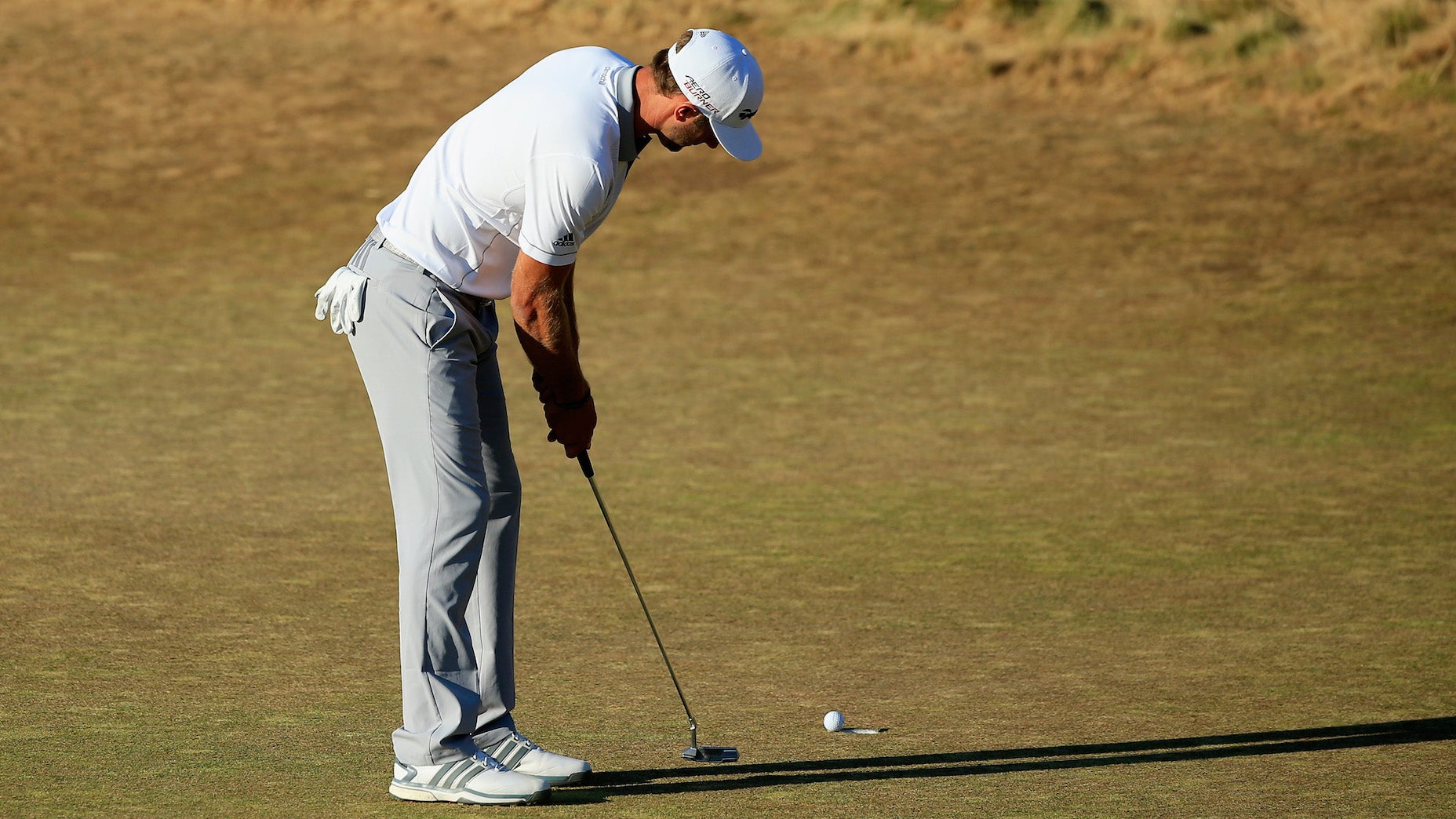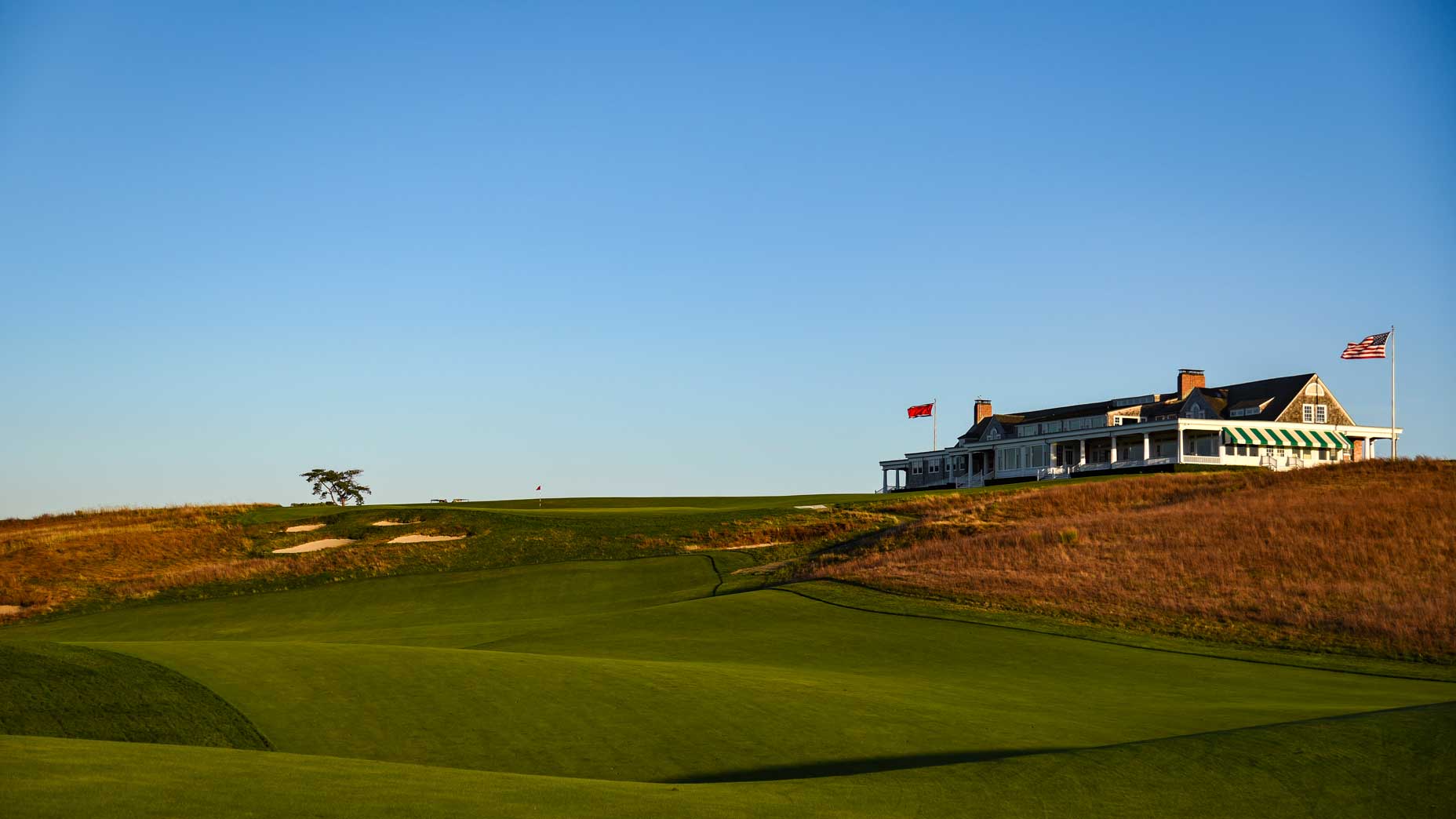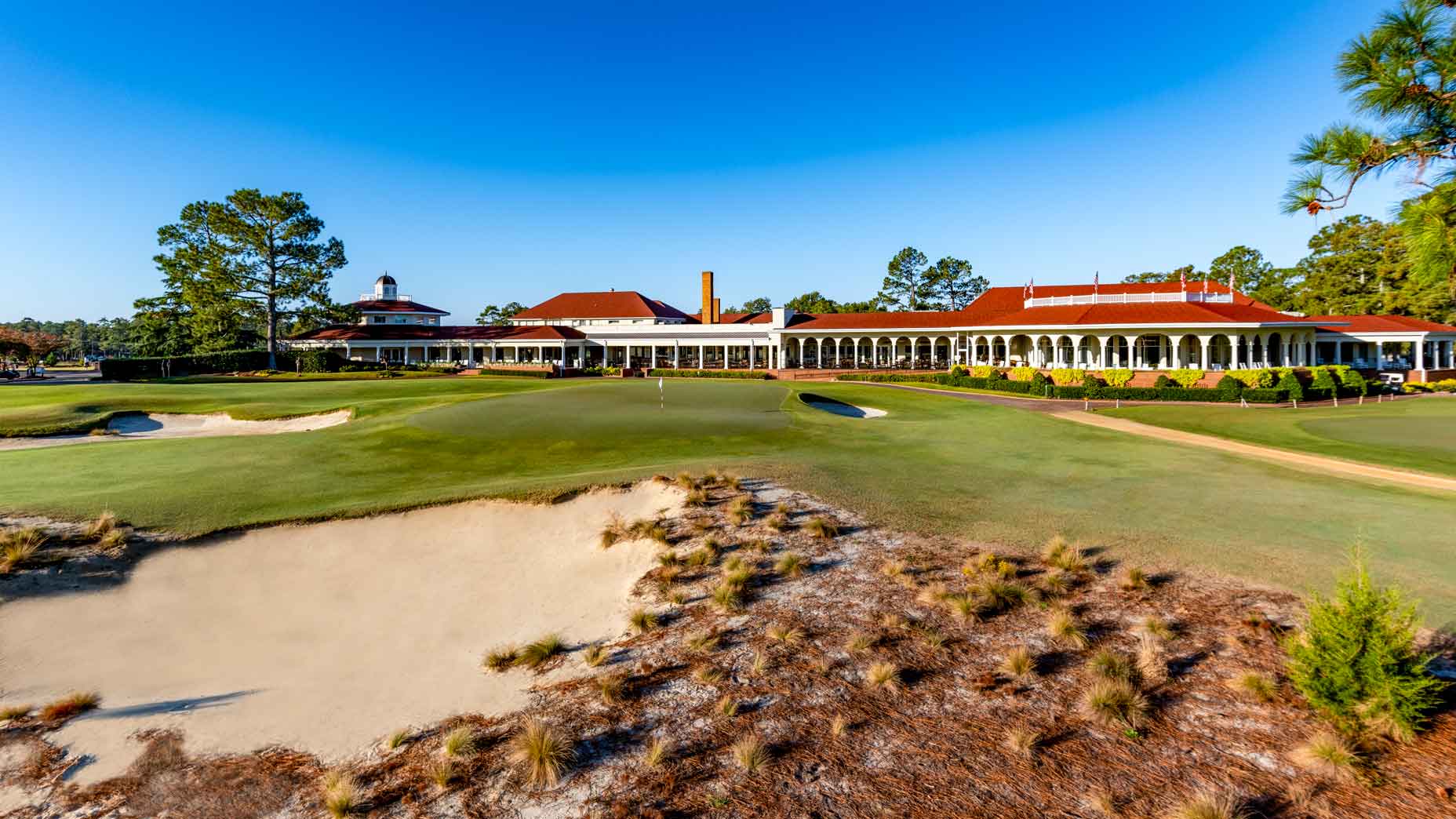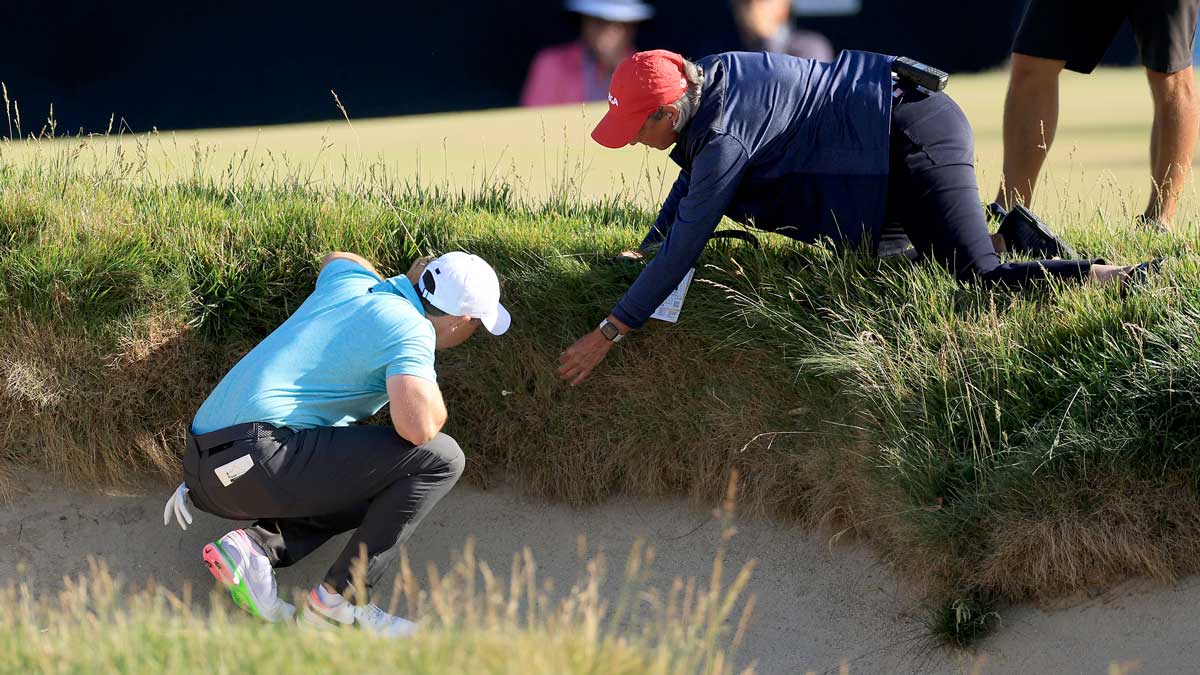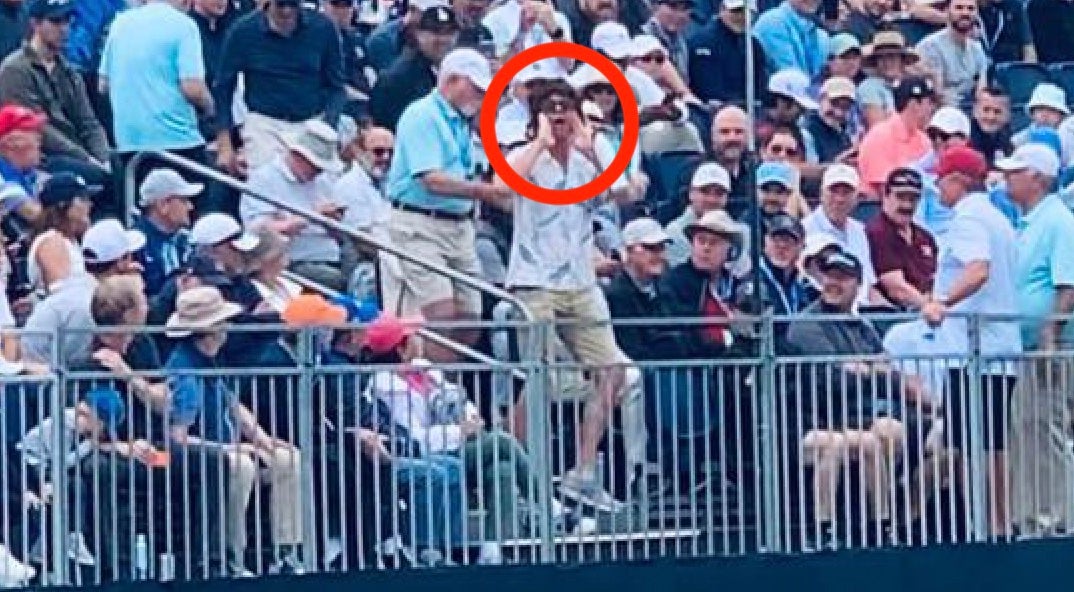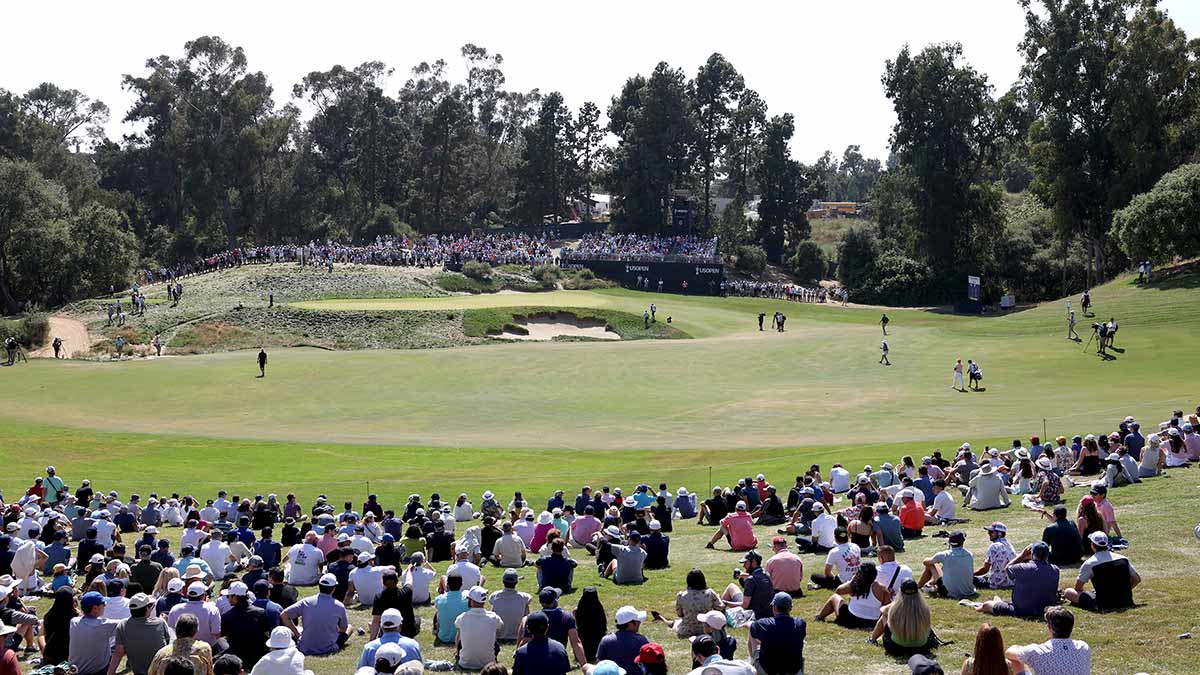One of the reasons the Masters has become such an institution on the sporting calendar is because every year, its arrival marks a shift in our own lives. The tournament ushers us into springtime. Viewers are inundated with the greenest grass and pinkest blossoms on earth. Our yearly television trip to Augusta National coincides with warm weather, with open golf courses, with sunshine. With prepping lawns of our own. With the possibility that this could be our best golf season yet.
If the Masters is a welcome to spring, the U.S. Open is an unabashed celebration of summer. The tournament is famous for its connection with Fatherās Day, but its ties to two other holidays ā the Summer Solstice and the Last Day of School ā are just as important. Golfās national championship transports us annually to a beautiful destination where 156 athletes spend all day outdoors playing the worldās largest, greatest lawn game in front of a fanbase with unlimited access to food and drink. The U.S. Open is a cookout, a road trip and a golf outing all in one. It serves as a reminder to live the summer dream, to take advantage of the warmth and daylight. To get out and play. To get out and live.
So I decided to do just that.
1. THE OTHER VENUE
Sunday, June 13
Ever since moving to Seattle last summer Iād been yearning for a trek down the coast. But as easy as it is to take a road trip, itās even easier not to. Obligations, real or manufactured, get in the way. To-do lists loom. Inertia sets in.
I have the obvious advantage of both ātravelā and āgolfā tying in directly with my job description, but even I needed something to set me in motion. Lucky me: A friend who works at a camper-van startup gave me a call earlier this spring, asking if Iād be interested in taking one of their vans for a spin. A plan started to come together in my mind.
What about a drive to the U.S. Open, Seattle to San Diego, celebrating municipal golf and road-trip summertime and covering the tournament once I got there?
I left Seattle Sunday afternoon, three-and-a-half days before the first tee shots would be in the air at Torrey Pines. A guy named Dave picked me up at my front door. Iād never met Dave before, but he was a friend of my cousin Johnās, happened to be in town for the weekend and was hoping to tick Chambers Bay off his bucket list. Plus he had a rental car. Golf, as always, is a useful connector.
If youāre muttering to yourself that Sunday afternoon is awfully late to leave Seattle, squeeze in a road trip to San Diego and arrive in time to cover the championship from start to finish then you, dear reader, should be organizing my travel. But there we were, heading an hour south to University Place, Washington, fired up to tour one of the nationās finest municipal courses.
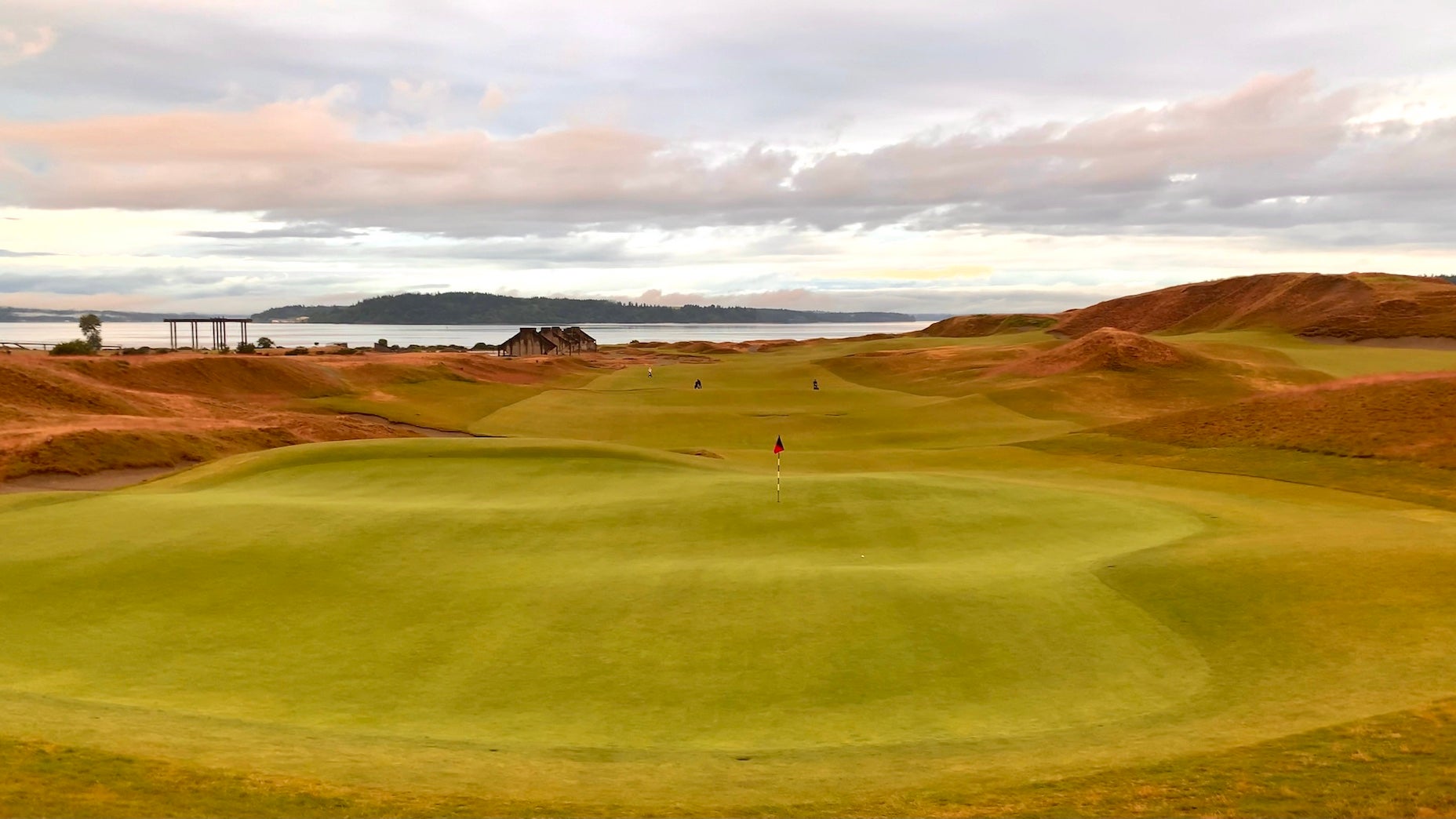
Every road trip to Torrey Pines should begin at Chambers Bay. Torrey and Chambers are the only two West Coast munis to host U.S. Opens. Theyāre each relatively affordable for local residents. Theyāre in spectacular locations with rich histories; Torrey Pines was a heavy artillery training facility and Chambers Bay was a rock quarry and gravel mine. Each has obviously now been converted into a championship golf course.
Torrey Pines first hosted the U.S. Open in 2008, when Tiger Woods edged out Rocco Mediate in a Monday playoff. Chambers Bay hosted the U.S. Open in 2015, when Jordan Spieth edged out Dustin Johnson by a shot thanks to a three-putt on 18. Youāve seen Torrey Pines every year since then, of course, if youāve tuned into the Farmers Insurance Open in January. But you may not have thought much about Chambers at all.
I was in the minority who absolutely adored the action at Chambers Bay that weekend. The course played firm and fast, its mounding provided a particularly different test and its dramatic visuals jumped off the TV screen. But public sentiment was mixed at best: A few discontented players, some hiccups with the inaugural Fox broadcast and Johnsonās unfortunate finishing three-putt became synonymous with the event itself. I wrote much more about it here but thereās one looming question at Chambers: Will the U.S. Open be back?
I teed off on Sunday afternoon at 4:10 p.m. with an excited foursome. There was the aforementioned Dave, a smooth-swinging six-handicap who had generously ferried me on site. There was Pat, my frequent Seattle golf partner, who swings like a scratch golfer but maintains a double-digit handicap. And there was another Dave, founder and CEO of Dave & Matt Vans, a former college hockey player with effortless speed off the tee; he was dropping off the big rig I’d be using for my subsequent trek to Torrey. Neither Dave had played the course before. We were an eager crew.
Over the next four-plus hours, our group was treated to a potpourri of Pacific Northwest weather. Drizzle. Dramatic fog. Heavy rain. Streaks of sunshine. By the time we played the finishing stretch ā No. 15 plays out towards the water, while Nos. 16 and 17 run alongside it ā things had miraculously cleared out for sunset. If you can get to Chambers Bay, take the latest possible tee time that will still allow you to find your tee shot on No. 18. We played at 4:10 p.m. but should have gone even later. The post-round view from the parking lot was the best of the day.
Torrey Pines is a spectacularly scenic site for a golf course, donāt get me wrong. But a week later, as I was watching the action unfold on Sunday evening in San Diego, I couldnāt help but think it would be that much more dramatic were it playing out in primetime along the Puget Sound.
THE VAN
Post-round, we paid up to Pat, the skins game champion, before performing one of golfās most satisfying rituals, swapping soggy clothes for dry, as Van Dave gave me a tour of my new home.
The story of Dave and Matt Vans goes something like this: Dave was working on Wall Street in New York City and wanted out. Matt was working as a teacher in Colorado and wanted adventure. The market for live-in vans was prohibitively expensive, so they made their own ā and then began to make them for other people, too. Ever since, their tricked-out Dodge Rams ā strategically available at a lower price point than nearly every competitor ā have been flying out of the garage as fast as they can make them.
Pat gamely volunteered to drop Dave at the airport on his way back north. I boarded my new vessel, excited if apprehensive. I had some experience in the road trip game, having spent an entire year living in a station wagon, but this was an entirely different animal. Would I be able to operate something this big? Would I be able to do so for 1500 miles? There was only one way to find out.
I backed up tentatively from my parking spot (thank goodness for the rear camera) and inched out the gate. The back roads were quiet. I eased my way to the highway.
Another 90 minutes down I-5, I felt a yawn coming on. Iād committed to exactly one thing before departure: if I got tired, Iād pull over. So I did. I swung the van into a rest area. I went from the front seat to the back seat. I typed the last bits of my weekly Monday Finish column and submitted it via hotspot off my phone. And then I rolled into the queen-sized mattress in the back, where I slept like Iād been hit with a brick.
2. THE VAN LEAVES TOWN
Monday, June 14
The only thing more American than a summertime road trip is trying to cram too many things into too little time on said road trip, sucking the relaxation out of it in the process. That was my realization as I slowed to a near-halt just outside of Portland, where Iād unwittingly joined the morning commute. My only intention each day was to drive, write, and play golf at a muni, but I hadnāt budgeted much time in for things like āeating,ā āsleeping,ā ābad weatherā and certainly not ātraffic.ā
In my planning dreams, Iād intended to sneak out to the coast for a round at Sunset Bay, a Coos Bay course in a state park just north of Bandon. Then Iād zip down to finish my day at Eureka Golf Course, a charming 5700-yard muni in Northern California. Daylight wasnāt cooperating. Neither was the weather. I made a hard reassessment and decided the coastal route would have to wait for another journey; in the meantime Iād stick to I-5, bust my way through a rainstorm and make as much southern progress as I could.
The van was easier to drive than I expected. I took extra caution merging, stayed settled in one lane as long as I could and braked with caution. (I’d been warned that if you go full slam then all untethered objects, including the mattress, can suddenly jump into motion.) But I soon eased into the rhythm of the road. The driverās seat is elevated and close to the front windshield, which means you always have a proper sense of where your van is in relation to everybody else.
I checked my texts during one stop for gas to find that Joel Dahmen had reached out to crack a joke about the van life and wish me safe travels. This isnāt meant as a name-drop ā I assure you, pro golfers donāt frequently reach out ā but instead because of Dahmenās answer when I asked him who was going to win the U.S. Open.
āIf Rahm doesnāt win, Iāll eat my shoe,ā he said.
More on that later.
Oregon zipped by out the window. Forest gave way to mountains. Roseburg. Grants Pass. Ashland. Iād been crowd-sourcing naming advice on my vehicle and, as I crossed into California, settled on Vaniel Berger. A reliable ball-striker seemed a fitting moniker for what I hoped would prove a steady chariot.
I considered stopping to play the particularly Californian āWeed Country Clubā but kept cruising past the town of Weed, then past Mt. Shasta, then on a bridge over the breathtaking Lake Shasta. I zipped through podcasts, some of them previewing the weekās action to come, allowing the musings of experts and fanalysts alike wash over me. Thereās a certain groupthink that happens in the lead-up to big-time golf tournaments, as prognosticators use the same data points to make the same educated guesses, guesses which end up being partially correct ā but which part? I settled on the idea that Torrey Pines, like most recent U.S. Open venues, would favor one of golfās solid-hitting bombers. Hardly a revelation, but still, it seemed unlikely to be Brendon Toddās week.
I realized Iād been driving for 10-plus hours as I neared the turn for my muni of the day: Bidwell Park in Chico, a mid-sized city some 90 minutes north of Sacramento. Like Griffith Park in Los Angeles, Warner Park in Nashville or Pelham Bay Park in New York, Bidwell is a massive, sprawling urban park that features hiking trails, running and biking paths, fields and playgrounds of every persuasion and, most importantly for my purposes, a golf course.
Many people donāt consider 6 p.m. a proper tee time, but thatās the sort of close-minded thinking that keeps you from taking on one of Northern Californiaās finest municipal courses on a serene evening in mid-June with only one care in the world: whether or not the McFlurry machine down the road would be operational post-round.
The young shop attendant at Bidwell Park began to quote me a price for an evening round before uttering the five greatest words in public golf: āYāknow what? Just go ahead.ā Then he added a sixth. āEnjoy!ā
An evergreen reminder, to myself and to you: Always be nice to the shop guys.
Bidwell Park felt timeless, the way any rural adventure tends to in the evening. In many ways it was; the park itself opened in 1905 and the original nine holes opened in 1920 (the current layout was finalized in the late 1980s). A few other groups dotted the course, ranging from a light beer- fueled foursome to a single playing a half-dozen balls on every shot. Choose your own adventure. I ripped through the front nine in just over an hour, racing daylight, eschewing practice swings, unhurried but unhindered, too. Golf, like most things, is best when shared ā but thereās a clarity and simplicity to the solitude of a solo round.
The front nine wound through the lowlands near the clubhouse, where I shared the fairways with a dozen or so deer, largely unmoved by my arrival. The back nine crossed a creek and zig-zagged into the foothills of the adjacent mountains. The shadows grew long but the wind stayed down, so it was plenty warm for an evening walk. I putted out on 18 and there was Vaniel Berger, waiting expectantly. We pulled out of the parking lot and past the gate, which was to be closed at sundown.
I received devastating news on the McFlurry front: only the drive-thru seemed to be open, and at nine feet, two inches in height, mine was not a vehicle suited for drive-thrus. I settled for some snacks from the Safeway down the street, parked and posted up in the back of the Berger, where I sent in a story on Chambers Bay and assembled what could loosely be called a turkey sandwich. A little dry, but plenty satisfying.
3. A TALE OF TWO COURSES
Tuesday, June 15
Professional golf is not always a sport suited for debate, which means that when we do have a question that everyone can answer differently, we dive in full-throttle. Thatās why the golf world tackles two unanswerable questions every summer. The first: Where should the PGA Championship be played? And the second: What about the U.S. Open? Itās not clear that weāve settled on obvious criteria for the host courses for either event, which means everyone gets his or her own opinion on the subject.
I stopped through TPC Harding Park on Tuesday, host site of Collin Morikawaās maiden major victory in 2020. Along with the Torrey and Chambers, Harding Park is the only other West Coast muni to host a major, and it served as a solid if unspectacular venue for the first post-quarantine major.
The argument for Harding Park as host goes something like this: Itās a very good golf course in a major metropolitan area with gorgeous trees and proper conditions, and itās important to showcase golf on a stage thatās publicly accessible if the golf world is going to demonstrate that itās a sport that can be played by anybody.
The counterargument goes this way: Fans donāt know Harding Park, they didnāt remember the holes from the Presidents Cup and itās unlikely to become a regular stop on the major championship circuit, so why bother? Harding Park was literally used as a parking lot for the 1998 Open at nearby Olympic. It should be treated accordingly.
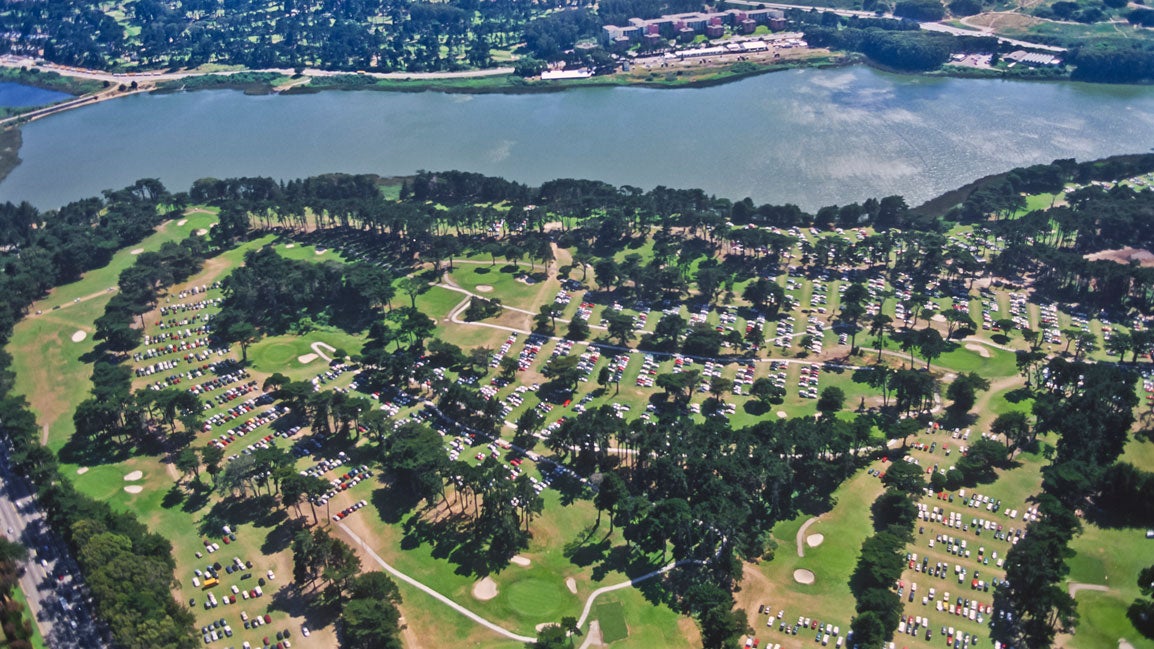
Thatās essentially the question both championships have to answer in the coming years. The greatest advantage of the Masters is that itās held at the same memorable property every year. But one potential advantage of the U.S. Open is as the Peopleās Tournament, held at a course where you could reasonably play. Should golfās rotating majors serve to introduce new courses to the general public? Or should they return to a select few so that fans get familiar with those venues and celebrate the little corners of Pinehurst, Oakmont, Shinnecock and Pebble Beach?
I planned to play Harding Parkās Fleming 9, the short course that sits at the interior of the property. But three semi-avoidable (and fully foreseeable) issues ā I stopped at a gym for a morning shower, at In ‘n’ Out for an early lunch and then ran into traffic between Sacramento and San Francisco ā plagued my plans again. I had an afternoon date down the coast, after all, one I was determined to keep. I left Harding Park behind and headed for the Monterey Peninsula, and the greater orbit of a far more famous major championship venue: Pebble Beach.
Pebble is public, but a room and a round will run you four figures per person, and thereās nothing āmunicipally ownedā about it, so it certainly falls under a different category than our three aforementioned major sites. And while architecture aficionados can squabble about the finer points of its routing, thereās no doubt that Pebble Beach makes for a terrific tournament host. Fans know the holes, itās intensely scenic and there are runs of dramatic golf on each nine.
I wasnāt actually headed to Pebble Beach itself, though. Instead I re-routed through the village of Pacific Grove, a bohemian town just up the coast from Spanish Bay, Cypress Point, Pebble Beach and the others. The town was awash in sun and abuzz with afternoon beach-goers, and I navigated the van through its narrow streets and up to the local golf course. If youāve read much about hidden gems thereās a good chance youāve heard of the āPoor Manās Pebble Beach,ā but let me be the next to testify on its behalf.
Pacific Grove is funky. I’ve certainly never played another course where the pars start 3-3-4-4-5-5, but thatās exactly how the front nine begins, wandering back through the neighborhood in a firm, fast, tricky setup. It doesnāt take long before you’re reminded that even 300-yard par-4s with steady winds, small targets and firm landing areas are nothing to take lightly.
I paid a $34 twilight rate and cruised around the front nine, navigating tree trunks and slippery slopes, managing the downwind holes okay and struggling just to stay in play once I turned back into the breeze. But if you find yourself on these hallowed links, donāt get frustrated with a bad start. The front nine is dinner and the back nine is dessert. You have to eat one to earn the next. And oh, what youāve earned.
When you cross the street from No. 9 green to No. 10 tee, what awaits is the scruffiest, linksiest slice of muni golf property I can think of in the U.S. After the short par-3 10th, No. 11 heads due west, where a dune guards the rear of the green and a walkway runs through it to the next tee. That stroll transports you into seaside paradise; the Pacific appears suddenly and overwhelmingly. The next six holes exist in sight of crashing waves and eager sunset-watchers, who populate the rugged coastline in vans and on bikes and by foot. The holes themselves are short and clever. Thereās a reachable par-5 followed by a drivable par-4. Beach sand and dunegrass soundly punishes any misses. Itās easy to imagine a birdie and itās easy to imagine putting the ball in your pocket, too.
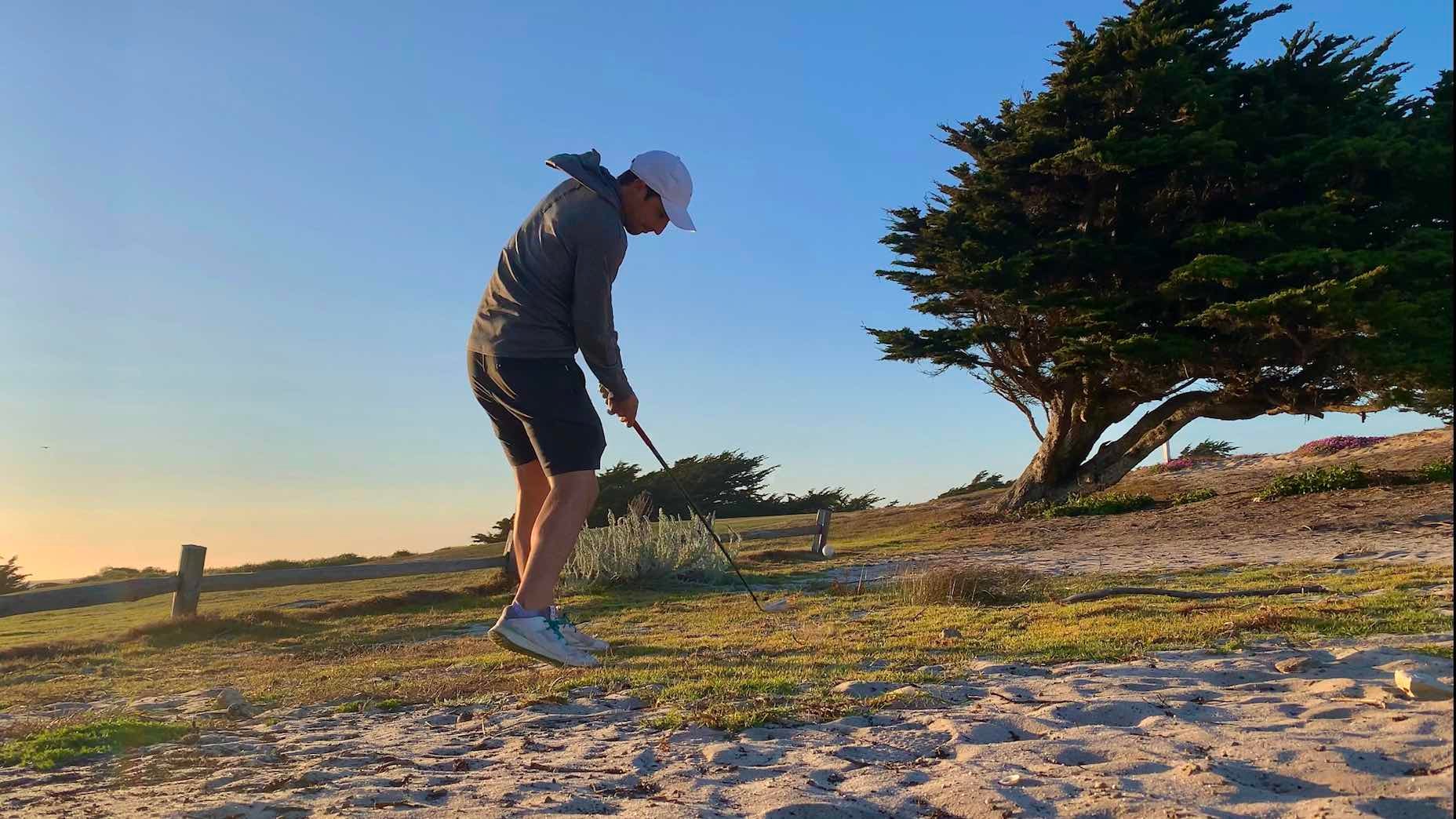
I caught up to a couple playing in front of me, whose game was closer to the āpicking upā end of the spectrum. No matter. I spent a while chipping on the 13th green, taking photos, wondering if Pebble Beach was worth 20 times the price Iād paid.
4. ON SITE
Wednesday, June 16
Iād driven late into the night on Tuesday but woke up early Wednesday anyway. The lead-up to a major championship can be plenty of fluff ā empty words in press conferences and off-base predictions about how the rough will play ā but thereās intrigue in that fluff, and itās still important to be there to decipher whatās real and whatās not.
I swung through my friend Mattās Los Angeles apartment, well-positioned just minutes off I-5, for a shower. Excellent water pressure. By the time I climbed back behind the wheel, I was a new man. Ninety minutes later I was better still: The orange cones and āLOT Fā signs emerged on the roadās right side. The finish line beckoned.
It was a funny thing to drive into media parking and realize that the fairways on which I was driving ā those of Torrey Pinesā North Course ā are the same that Tour pros will be playing in the first two rounds of next winterās Farmers Insurance Open. Parking on a Tour fairway. The U.S. Open trumps all.

Not all major Wednesdays are created equal. At the Masters, Wednesday means final tune-ups and the Par-3 Contest. But at the U.S. Open, light is plentiful and Thursday tee times are far more spread out, which means thereās plenty of work still to do on Wednesday. Pros and coaches filled the two-level driving range. The afternoon tee sheet was jam-packed.
Iām always fascinated by these practice-round groupings. How does Rory McIlroy end up playing with Henrik Stenson and Matthew Southgate? Why was Brooks Koepka teeing it up with Matthew Fitzpatrick, Zach Zaback and Victor Perez? But I was most interested in tracking down one player who the professional golf world hadnāt seen in months: Matthew Wolff.
I walked most of the front nine with Wolff and his coach George Gankas. Mostly I gave them space to practice, strategize, plot out the Torrey attack. But during in-between moments there was time to chat. Wolff hadnāt played an individual stroke-play event since the Masters two months before, skipping a slate of high-profile tournaments including the PGA. How was he feeling now?
āIām OK,ā he told me earnestly. Not great. Not terrible. OK. He expanded on the idea that heād been feeling a lot of pressure to perform, pressure to win, pressure to be perfect.
āSometimes itās a lot of pressure, and I think it got a little intense. It got too much,ā he said.
Gankas, though, emphasized that if Wolff could be patient with himself, heād have a good chance at getting into contention.
āThe rough doesnāt affect him in any way at all. Itās weird,ā he said.
(I wrote more about the exchange here.)
The range emptied out by late afternoon. I took a chance and parked at the state beach just down the hill, a mere three-minute drive from the course. There was some signage suggesting cars werenāt meant to park overnight, but a dozen other vehicles were lined up. I climbed into the back of the van early that night and popped open the window in the roof to listen to the waves roll in.
5. THE TOURNAMENT BEGINS
Thursday, June 17
I woke up early to the crash of surf and the chatter of paddleboarders, who were starting to gather in the parking lot. Inspired by a true nightās sleep and what was certain to be a fog delay at the course, I went for a jog along the beach. In the time before drone shots, Torrey Pinesā rugged beauty didnāt always translate through the TV screen, but on a misty morning run along the cliffs, I didnāt need much convincing.

After a satisfying ocean swim and a change into reporter-respectable attire (not a high bar to clear) I pulled the van through the media entrance. Play was about to begin.
Ten hours later, weād learned marginally more about the form this championship would take. Torrey Pines played tough but not brutal. The rough was rough but still playable. There were some surprises near the top of the leaderboard but there were plenty of familiar names within striking distance. And Brooks Koepka was doing his major championship thing. Again.
As afternoon gave way to evening, the fog rolled back in. The temperature suddenly dropped. Most of the fans went home. And the remaining groups played on through the finish.
Not everybody was happy. Webb Simpson shot 79. Phil Mickelson was dismayed by the number of fans who found themselves unable to silence their phones. And Bryson DeChambeau hit balls on the range at least an hour past sunset, well into the pitch blackness.
I wrote ’til dark, too, arguably a less strenuous accomplishment. But I left smiling. DeChambeau did not. Then I got tacos. And I found a parking spot on a quiet street in Rancho Santa Fe, where Iād be conducting some research the next morning. Put another way: I had an early morning tee time.
6. WHERE THE PLAYERS PLAY
Friday, June 18
After Phil Mickelson won the PGA Championship, he credited Xander Schauffele with helping him tune up for golfās biggest stage. He talked about getting drubbed by Schauffele during one stretch last summer and learning from the way Schauffele managed his game and managed the golf course, hitting everything pin-high and picking his spots to get aggressive.
At one point, Mickelson had lost two consecutive days to a 64 and a 63, and Mickelson took on Schauffele a third day in a row. Down a press, he tried to seize momentum on the third day by hitting first on the lengthy par-3 16th, and it seemed to work: He hit it to four feet.
Then Schauffele made an ace on top of him. He shot 62 that day.
āI went back and talked to [his wife] Amy and Iām like, āI donāt know how Iām going to beat this guy. Heās probably playing the best of any player in the world right now,āā Mickelson recalled.
Those matches ā and most San Diego Tour pro showdowns ā were played at The Farms, a private club some 16 minutes from Torrey Pines. The Southern California Tour crew doesnāt have the number or caliber of the pros who populate Jupiter, Fla. or Scottsdale, Ariz. But if thereās one crew youād have to pick to hang with, these might be your guys. Mickelson and Schauffele play The Farms with Charley Hoffman, Emiliano Grillo and a bevy of scratch ācaps and local mini-tour pros. Max Homa joins them sometimes, too.
Vaniel Berger rolled through the front gate at The Farms at 6:45 a.m. on Friday morning for an early-morning round. I drew the invite out of happy coincidence; on a previous trip to San Diego, my colleague Sean Zak and I played Torrey and were randomly paired with Eric, who turned out to be a regular in games at the Farms. Heād promised a round and here I was, cashing it in.
Mickelson, Schauffele, Hoffman and Homa were over at the tournament, but there were plenty of players left for a proper match. I drew Grillo as my partner. Lucky me.
Whatās it like playing with a PGA Tour pro? Well, itās like playing with any scratch golfer, just fine-tuned. Grillo doesnāt necessarily hit it farther than your long-hitting buddy ā heās a respectable 77th on Tour in driving distance, a shade under 300 yards ā but he hits it better than your buddy. His contact is crisp. His action is efficient. He can carry a washed-up golf writer to a tied match against two serious plus-handicaps. And he’s focused, too. Not slow. Not intense. But he lines up his putts properly, and he takes an extra moment to get settled over the ball, and when he hits it, he means it.
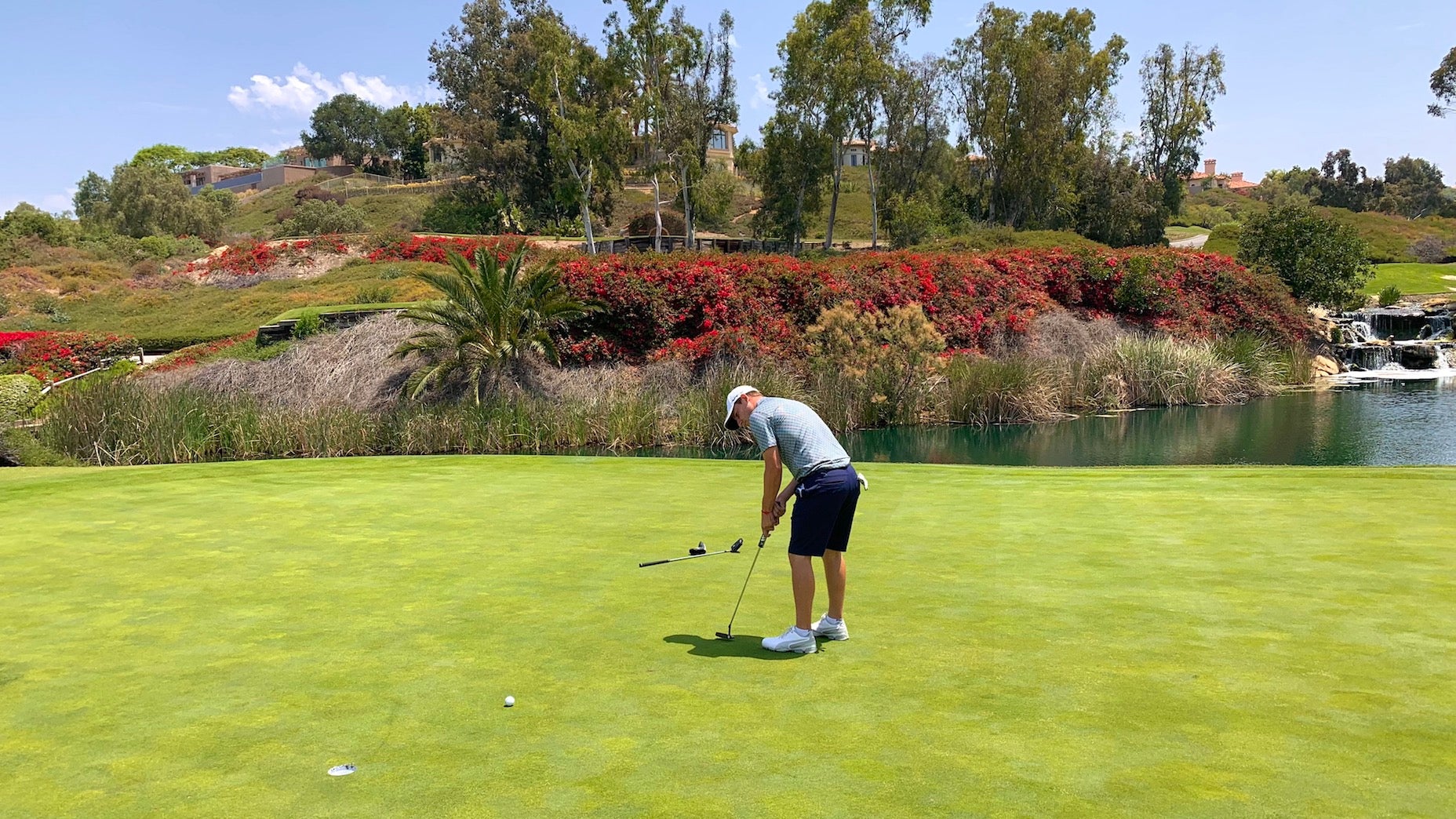
The flip side of playing with a PGA Tour pro is that you feel generally inadequate. I swung tight all day. On No. 1, I actually hit one close but missed the putt, letting down my partner. On No. 3 he said to hit it anywhere but right and I hit it right. On No. 17, with the match hanging in the balance, I faced a lengthy two-putt and lipped out the second. And on No. 18, I curled in a birdie putt only to watch Grillo and an opponent tie the hole (and the match) with eagles.
The round was a particular reminder that the guys who play on Tour are real people. They play and practice with other real people. If youāre a decent golfer you could beat Phil Mickelson on one hole, or even on a stretch of holes. Mini-tour pros can beat PGA Tour pros over the course of a full round. But over the course of a stretch of rounds, or a season, these guys will remind you that they are unfathomably better at golf.
Back at the course, Richard Bland was doing the unthinkable. Mickelsonās PGA had numbed us to the shock value of a seasoned vet leading a major championship, but still ā Bland was a 48-year-old playing in just his second-ever tournament on U.S. soil. This was preposterous.
Inspired by a morning at their club, I spent the afternoon tracking the Southern California group of Homa, Mickelson and Schauffele. Mickelson made an inspiring charge inside the cut line. Schauffele looked like he could be leading the tournament but stalled out instead. Homa rallied to the cut line but then quickly faded. Friday is when the picture of the tournament starts to become clear, and not just because the field gets chopped in half.
I listened to Homaās podcast with Shane Bacon at the week’s conclusion, curious to hear his review of a missed cut. I was particularly taken with what he said about Schauffele, so I transcribed one section, which he begins with a conversation with his wife after their Friday round:
āI was like, āXander shot even today,ā and she was like, āI canāt believe how easy he makes it look. It didnāt seem like he was doing anything.ā I mean, the kid is just ā Iām obviously biased, because Iām a friend of his, and Iām a huge fan of his, but there will be a time where heās gonna win one of these, and similar to Rahm, it could get kinda scary for a bit, with how many he might be able to win. Iām talking majors, PGA Tour events, both. I donāt like when people say āOh, this guyās gonna rattle of three, four majorsā ā Dustinās won two, and heās as good a golfer as anybody. But [Xander] is that guy. When he starts winning these things, I think especially in regular PGA Tour events, he could start coming multiple times a year and you wouldnāt even be shocked when he does it because it looks so simple. So I just wanted to give him a shoutout, heās really good.ā
Thatās the Xander Schauffele experience. The folks at the Farms would agree. And through two rounds at Torrey Pines heād played his way into the fifth-to-last group ā well within striking distance.
6. MOVING DAY
Saturday, June 19
Besides the van, if I could provide one full-throated endorsement from this trip it would be of the Dan McKinney Family YMCA in La Jolla. Thatās where I began my Saturday morning and wow, what a facility. If youāre new to an area, YMCAs typically give some sort of guest pass (two free days, in this case). I would say I took full advantage but that would have required swimming, hooping and taking a crack at some gymnastics. But if youāre looking for a gym and a shower, youād be hard-pressed to beat what the McKinneys have brought to La Jolla.
I arrived at the course fully refreshed and ready to track the drama of moving day. Two players had my immediate attention: Brooks Koepka and Bryson DeChambeau. I wanted to see how they were each treated. Hereās where I landed:
Koepka is, in the larger sports world (and on the internet) more universally respected. His trash-talk, his machismo and his alliance with Barstool seem to all be paying dividends. But in person he favors tunnel vision over engaging with fans.
DeChambeau, on the other hand, draws louder cheers but louder jeers, too. Heās polarizing, and heās beloved, but not universally. He wants everyone to like him, and to understand him, and he goes out of his way to interact with the crowd, even if he doesnāt always come across how he hopes.
They began the day tied at even par and each made a move towards the top of the leaderboard. DeChambeau sustained the charge and finished his round at three under. Koepka stalled out and went backwards, finishing the day where heād started.
Midway through the day, though, I felt the gravitational pull of a group up ahead: Rory McIlroy was cominā. The roars came from up ahead of Koepkaās group. He made five birdies against just a single bogey, making hay from what he called a āboringā round of golf.
āIāll take boring all day at a U.S. Open,ā he said after he finished.
My greatest contribution of the week to the culture was probably my post-round question to McIlroy. What did he plan to do in the 18 hours between the conclusion of his Saturday round and his Sunday tee time?
McIlroy was hungry, so he wasnāt looking too far ahead.
āIāve had the same chicken sandwich five nights in a row from room service, so Iāll probably make it six nights in a row,ā he said. That sandwich? Rotisserie chicken, avocado, sun-dried tomatoes and garlic aioli on whole wheat.
āItās really good.”
I believed him.
As the day wound down, the field of likely contenders crystallized. Russell Henley posted five under. Mackenzie Hughes made a back-nine charge to join him there. Louis Oosthuizen poured in an eagle putt at the last to land at five under, too.
Behind them, the starts had bunched up together. McIlroy and DeChambeau at three under. Rahm, Wolff and Scheffler at two under. Morikawa, Johnson and Schauffele at one under. Koepka at even par. After another van video recap and some more tacos, I pondered the potential outcomes, but not for long.
7. THE CIRCUS LEAVES TOWN
Sunday, June 20
Thereās a hilarious mental adjustment that happens between waking up in the back of your van in a dirt parking lot and pulling confidently, some 20 minutes later, through the gates of The Bridges, a Rancho Santa Fe enclave that the local paper once called āThe Louvre of the North County private clubs.ā I skipped the valet. Some cars were meant to be parked on oneās own.
I was playing that day with my colleague Brian, a young plus-handicap member named Andy and Chip Brewer, the CEO of Callaway. Iād interviewed Brewer for a story on their acquisition of Topgolf some months earlier but had never met him in person; this was a chance to pick his brain on his vision as the head of one of golfās most prominent brands.
Weāll get into that another time, but for now Iāll just say Brewerās game made me feel inadequate in a distinctly different way than Grillo’s had the day before. Youāre not supposed to be CEO of a large corporation and also break par, but he poured in a lengthy birdie putt at No. 17 and got up-and-down at 18 to shoot an honest, every-ball-in-the-hole round of 70. As his opponent, distressing doesn’t begin to describe it.
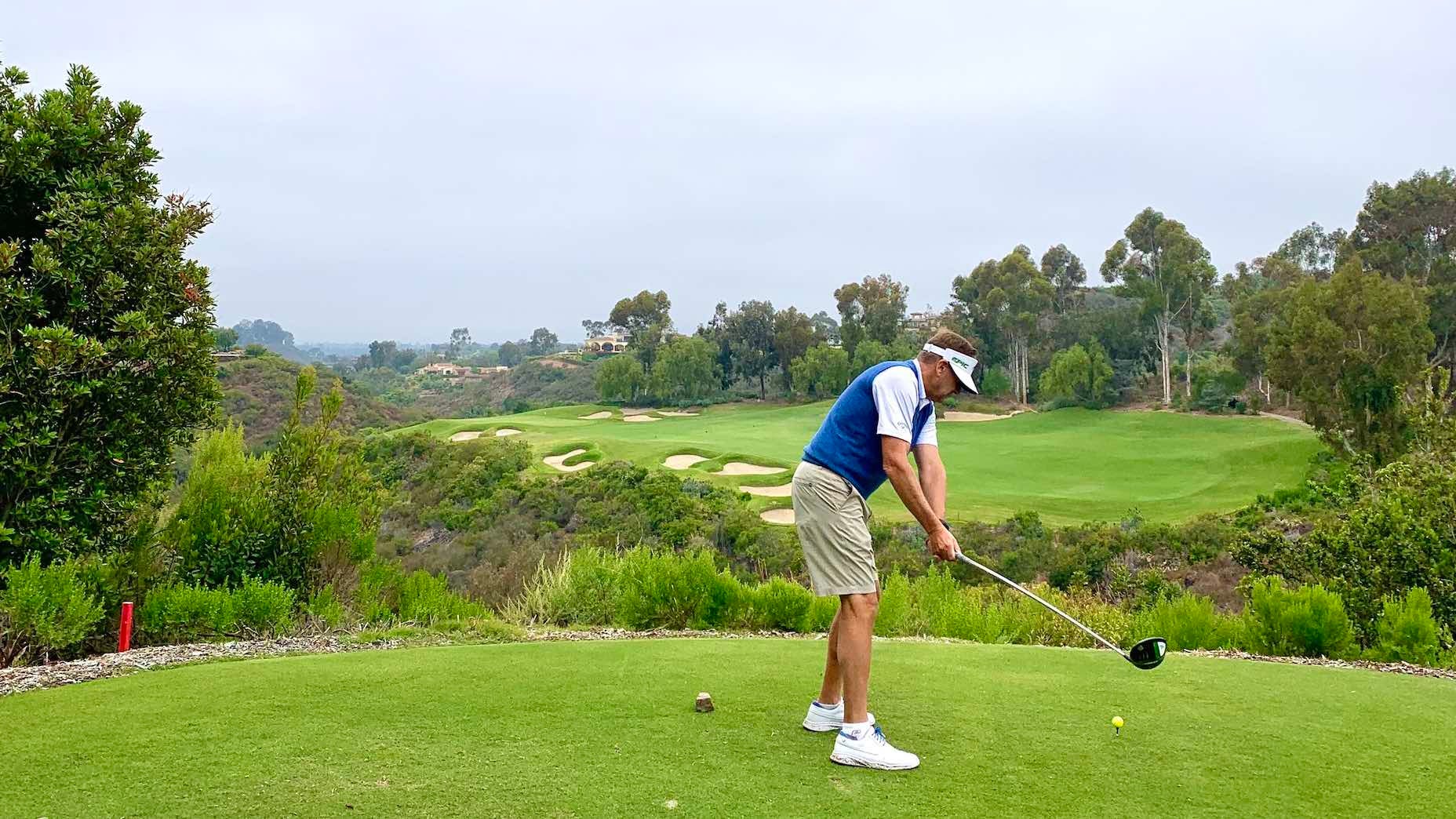
The Bridges proved a delightful surprise. When I think of San Diego golf I donāt typically think of scenery, drama or elevation change, but Robert Trent Jones, Jr. built in all three when he designed this place in the 1990s. The course winds in and out of canyons and ravines, allowing for plenty of vistas of the nearby hills as well as the mansions that increasingly fill in between them.
The course is also extremely well-named; the bridges really tie the place together. Several suspension bridges connect one hole to the next, hammering home the idea that these holes are carefully balanced near the top of a canyon. No. 10 is a drivable par-4 that features an elevation drop from the tee, a ravine guarding the left side, a view down the canyon in the distance and a large bridge delivering you to the fairway. That, in a nutshell, is the Bridges experience.
Combine the dramatic topography with the villa-style architecture and you start to get the sense that you could be in the Italian countryside. Small vineyards and orange trees border several fairways, and fruit literally bounds down the hillsides into play. This is the good life. And, as I reminded myself while snacking on dried blueberries at one of the hospitality buildings, itās a heck of a long way from Pacific Grove.
Early tee times are a beautiful thing; by the time I piloted the renamed Vander Schauffele into Lot F, the late groups were still warming up. What a Sunday lay ahead.
The best way I can explain the final round’s sequence of events is this: After the round, Jon Rahmās victory felt like a foregone conclusion ā but that was certainly not my real-time experience on the ground. The afternoon began as an open question and then turned to a game show, cycling through a cast of likely winners. When Russell Henley birdied No. 3, he felt likely to at least be there at the end. When McIlroy birdied No. 4, he suddenly seemed the betting favorite. Bryson DeChambeau hit his tee shot at No. 8 so close he could have tapped it in with a protein shake. Now he held the lead. But three holes later, heād made bogey and Oosthuizen had poured in two birdies. Would the back nine be King Louis’ coronation?
I wrote about the chaos of the back nine that evening, but to sum it up: Most of the contenders ejected down the stretch. Oosthuizen stayed steady. Rahm seized the moment.
I saw both of Rahm’s putts fall in from a distance. Mostly I heard them, loud and clear. Rahm is an underrated celebrator and here he had plenty to celebrate, stealing a win on the final two greens in improbable fashion. If he faces both putts 100 times, how many times does he make both? Two? Three? When he rolled in that second putt, he roared, and the crowd roared with him. The moment was well deserved.
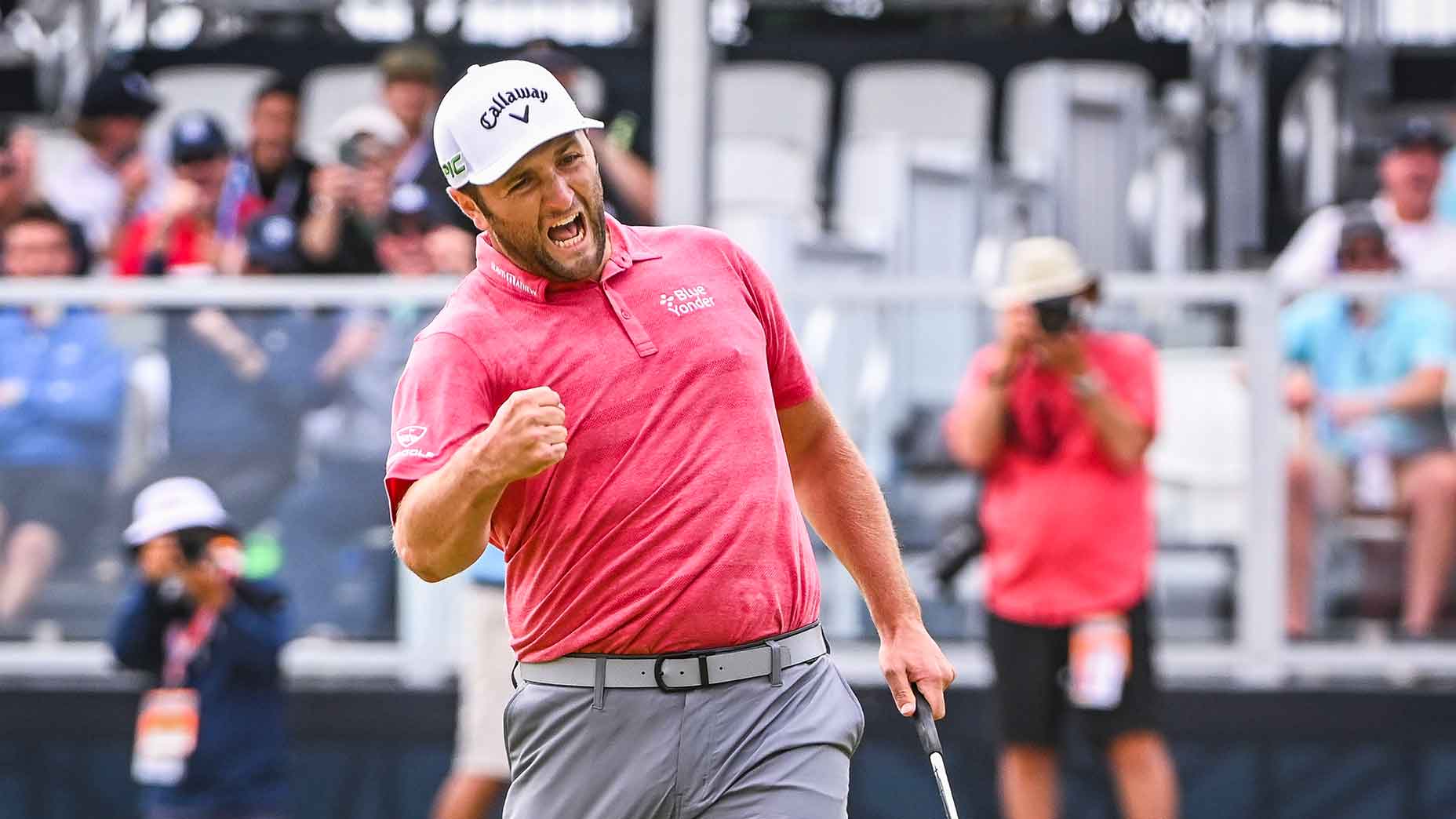
At the conclusion of a major championship, there’s always a moment where they begin to clear the proverbial confetti. And Iām always struck with an immediate sense of anticlimax. Front-row bleacher seats go from priceless to valueless. The logistics that have gone into building a stage for this massive event suddenly shift to un-building it. The infrastructure begins to come down. The players begin to leave town.
The craziest part about it, to me, is just how many players keep on trucking to the next stop on the schedule. Homa, who had missed the cut at the U.S. Open, practiced at Torrey all weekend. Harris English made an inspired Sunday charge to finish solo third. Guido Migliozzi played the tournament of his life to end up T4. Koepka had a rollercoaster week end with a thud of a bogey at 18, but he, too, settled for T4. All four of those guys headed 2,800 miles to Hartford, Conn. for the following weekās Travelers Championship.
I parked that evening at the Gliderport, the takeoff spot for those hang gliders you see by the third and fourth holes during the championship. At night itās a mix of Van Lifers and star-gazers. By morning itās a surf spot with access to an adjacent nude beach. Something for everyone.
I stayed up late, typing and eating and organizing my things. The sun didnāt set until after 8 p.m., which meant there was light in the sky as I packed up the back of the definitively-renamed Dodge Rahm. This was a one-way van trip, and I was making the drop the next morning on the way to the San Diego airport.
It was a bittersweet feeling, leaving the van and the U.S. Open behind. After all, Monday would mark June 21st ā the solstice and the first official day of summer. Adventure lay ahead.
But there’s a sadness to the longest day of the year, too, knowing each day will only get shorter from there on out.

